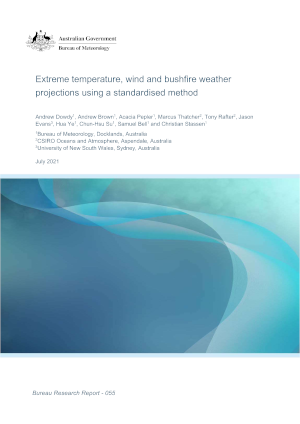Climate Change in Australia
Climate information, projections, tools and data
ESCI Project Reports
Publications / Project Reports
ESCI Project Report
The ESCI project was funded by the Department of Industry, Science, Energy and Resources (DISER). It was delivered by the Commonwealth Scientific and Industrial Research Organisation (CSIRO) Climate Science Centre (CSC), the Australian Bureau of Meteorology (BOM), and the Australian Energy Market Operator (AEMO), the project’s primary stakeholder, between March 2019 and June 2021. The project final report covers: 1) the identified need that the project addressed• the design of the project and stakeholder participation, 2) the ESCI Climate Risk Assessment Framework, 3) the approach to developing and delivering the climate data including the recommended data sets, 4) project monitoring and evaluation and the impact of the project (as far as it can be assessed within its lifetime), and 5) gaps and limitations of the project and a vision for the future.
Publications / Project Reports
Report on the first Weather and Climate Risk Scenario
The first climate scenario workshop focused on the near-term future (2021–2023) and on two themes: reliability and resilience planning. Participants at this cross-sector workshop identified ways in which the National Electricity Market infrastructure was vulnerable to climate hazards, and was instrumental in defining the key hazards and case studies that became the focus of the project.
Publications / Project Reports
Draft - The use of case studies of extreme/compound events in risk assessments
The ESCI team demonstrated a methodology for identifying extreme and compound events in the climate projections and provided the sector with a quantitative case study of a compound weather event based on the weather 'signature' of ‘Black Saturday’ in February 2009. This case study was used in six sector focus groups to explore: how decisions to support system resilience in the face of extreme events are made whether the information that can be provided by climatology can be used to inform these decisions what decision-making practices would need to change to use this information more effectively to support power system resilience
Publications / Project Reports
Draft - Downscaling and evaluating data sets
The ESCI project team considered the strengths and weakness of existing data sets and a decision was made early in the project to undertake additional downscaling. The project delivered high resolution climate projection data to 2100 (5–12 km across the NEM, at sub-daily intervals) from CMIP5 climate models using tailored downscaling methods and sophisticated statistical adjustment. These data sets provide the sector with a standard suite of information on key climate variables which will answer the most pressing questions on future climate risks. In order to be confident in the results of this process, it was important to undertake a rigorous quality assurance process for the different data sets.
Publications / Project Reports
Extreme temperature, wind and bushfire weather projections using a standardised method
Projections for weather and climate extremes are challenging because the models have significant limitations in simulating the required physical processes. Consequently, the information required for risk assessments by electricity sector stakeholders is not as simple as just providing raw model output data. The ESCI team developed the Standardised Method for Projections Likelihood (SMPL) building on earlier work by the ESCI team scientists. They compiled ‘Lines of Evidence’ tables which provide evidence-based assessments of the likelihood and confidence in trends for the key climate hazards based on published climate information, physical process understanding, observations and model output.








